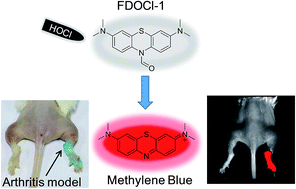当前位置:
X-MOL 学术
›
Chem. Sci.
›
论文详情
Our official English website, www.x-mol.net, welcomes your
feedback! (Note: you will need to create a separate account there.)
Deformylation reaction-based probe for in vivo imaging of HOCl†
Chemical Science ( IF 7.6 ) Pub Date : 2017-11-03 00:00:00 , DOI: 10.1039/c7sc03784h Peng Wei 1 , Wei Yuan 1 , Fengfeng Xue 1 , Wei Zhou 1 , Ruohan Li 1 , Datong Zhang 2 , Tao Yi 1
Chemical Science ( IF 7.6 ) Pub Date : 2017-11-03 00:00:00 , DOI: 10.1039/c7sc03784h Peng Wei 1 , Wei Yuan 1 , Fengfeng Xue 1 , Wei Zhou 1 , Ruohan Li 1 , Datong Zhang 2 , Tao Yi 1
Affiliation

|
The detection of hypochlorous acid (HOCl) in vivo is vitally important because the local concentration of HOCl is highly correlated with some diseases such as atherosclerosis and rheumatoid arthritis. However, in vivo detection of HOCl remains a challenge due to the lack of a suitable probe. We report here a near-infrared (NIR) emissive “turn-on” probe (FDOCl-1) based on a methylene blue derivative, which can quickly detect HOCl via a newly found deformylation mechanism. FDOCl-1 displays remarkable selectivity and sensitivity towards HOCl. The dramatic changes in colour and NIR emission were used to detect HOCl in vitro and in vivo in a mouse arthritis model.
中文翻译:

基于脱甲酰化反应的探针,用于 HOCl 体内成像†
体内次氯酸(HOCl)的检测至关重要,因为HOCl的局部浓度与动脉粥样硬化和类风湿性关节炎等一些疾病高度相关。然而,由于缺乏合适的探针,HOCl 的体内检测仍然是一个挑战。我们在这里报告了一种基于亚甲蓝衍生物的近红外(NIR)发射“开启”探针( FDOCl-1 ),它可以通过新发现的去甲酰化机制快速检测HOCl。 FDOCl-1对 HOCl 显示出卓越的选择性和灵敏度。颜色和近红外发射的显着变化用于在小鼠关节炎模型中体外和体内检测次氯酸。
更新日期:2017-11-03
中文翻译:

基于脱甲酰化反应的探针,用于 HOCl 体内成像†
体内次氯酸(HOCl)的检测至关重要,因为HOCl的局部浓度与动脉粥样硬化和类风湿性关节炎等一些疾病高度相关。然而,由于缺乏合适的探针,HOCl 的体内检测仍然是一个挑战。我们在这里报告了一种基于亚甲蓝衍生物的近红外(NIR)发射“开启”探针( FDOCl-1 ),它可以通过新发现的去甲酰化机制快速检测HOCl。 FDOCl-1对 HOCl 显示出卓越的选择性和灵敏度。颜色和近红外发射的显着变化用于在小鼠关节炎模型中体外和体内检测次氯酸。











































 京公网安备 11010802027423号
京公网安备 11010802027423号